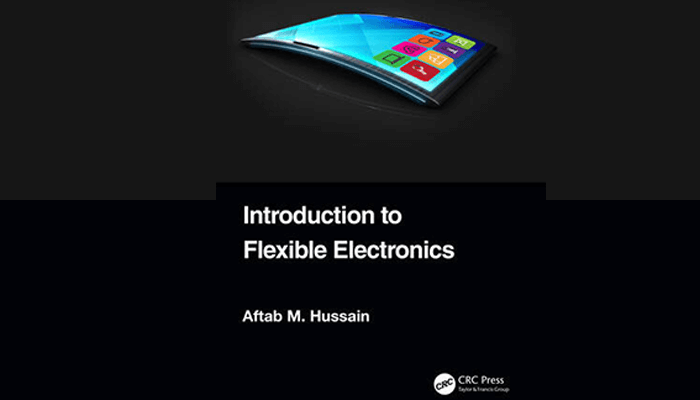Ever wondered how a block of aluminium is stiff and unyielding while the same material can be malleable when rolled out as aluminium foil? Or how the bark of a tree is hard while paper is supple despite being made up of the same cellular fibre? Answers to these and more can be found in the first formal and lucid Introduction to Flexible Electronics authored by Dr. Aftab Hussain, principal investigator of the PATrIoT (Processes Architecture and Technologies Research in IoT) lab at IIITH.
When Dr. Aftab Hussain kickstarted a course on Flexible Electronics at IIITH in 2018, he knew it was one of a kind. “World-wide there are only a handful of universities that are offering a semester-long course on flexible electronics. Elsewhere there are summer courses, one-week long courses and so on, but a detailed 4 credit, full semester course with a project component in the mix, IIITH is definitely the first in the country and one of the few in the world,” he acknowledges. Flexible Electronics is an emerging and ever-evolving field of the science and materials behind properties of electronic devices that cannot be fulfilled by conventional electronics. The challenges of being a first-mover however, are a-plenty and for Dr. Hussain, finding good quality resource material that his students could refer to was one such.
Plugging A Gap
While one can find edited books or collated book chapters on specific topics of Flexible Electronics written by different research groups or individuals, the professor discovered a void in Electronics literature with the lack of a single book documenting it from start to finish. “Book chapter collections are a good compilation of the current state-of-the-art in a specific area and are definitely very valuable but they are not a substitute for text books,”’ he remarks. Having to design and structure a course from scratch based on all his years of training and research in the area, Dr. Aftab realised that an old-fashioned textbook could be written following the same structure.


300-Page Tome
Dr. Hussain’s dedicated efforts over 2 years have now resulted in a 19-chapter first look at the world of flexible electronics. Divided into 5 parts, the text book titled “Introduction To Flexible Electronics” covers topics from a simple introduction to why things are flexible, to the materials and their properties that make up all electronic devices; from the integration strategies to the applications in devices that are now available such as flexible processors, memory, display, photovoltaics, and so on. The final chapter also provides a sneak peek into another emerging world of stretchable electronics. “This is like one step ahead of flexible electronics in which the electronics is actually stretchy like a fabric or a textile,” explains Dr. Hussain.
Following the classic textbook-style approach, each chapter culminates with an exercise. In addition to this, there are solved and unsolved problems interspersed through out the book. “All the chapters take into account first the rigid electronics component, the working principle of the rigid structure and the problems associated with getting them into flexible electronics. Sometimes we talk about the solutions and in some cases, I have had to leave it open-ended because really there’s no answer to that in the world at the moment. Research is on-going,” explains Dr. Hussain.
Easy Breezy Light Read
With the primary target audience being senior undergraduates or graduates in electrical engineering, electronics, materials sciences, chemistry and communication engineering, the book aims to be an easy read. “This style is by design because the other edited book chapters are very technical and detailed, making them a heavy-read. It is nice of course to read such detailed research if you are a PhD student but as an introduction to the field or as a course reference, there was nothing out there so that’s why I kept it extremely simple,” says Dr. Hussain, adding that it has been specifically designed to help educators in developing a course in flexible electronics. “My wish is that a lot of faculty in India and abroad use this book to structure their curriculum around it and use the exercises in it to set semester-end exam papers so that their students can refer to it as a textbook,” he says.
The book is available on the international publisher’s website: https://www.routledge.com/Introduction-to-Flexible-Electronics/Hussain/p/book/9780367439668
As well as on Amazon:
https://www.amazon.in/dp/0367439662?tag=tafrboinpvlt-21
Sarita Chebbi is a compulsive early riser. Devourer of all news. Kettlebell enthusiast. Nit-picker of the written word especially when it’s not her own.

